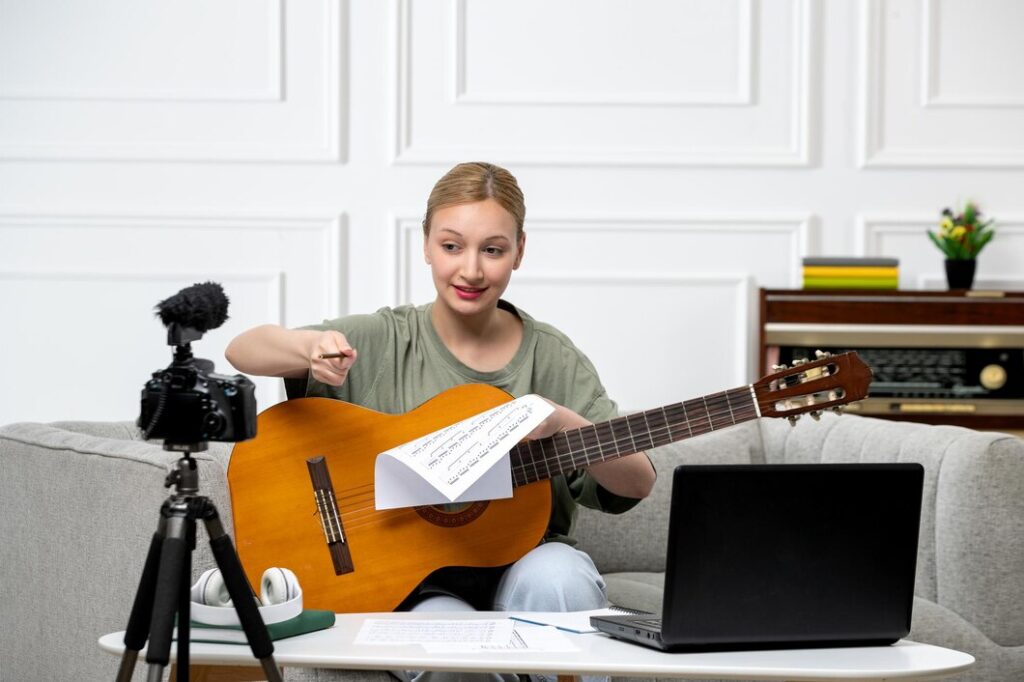Learn how to get setup to teach online music lessons. Including, which software to use and which webcams and equipment to get.
Table of Contents
The digital age has transformed many aspects of our lives, and music education is no exception. Online music lessons have become increasingly popular, offering flexibility and accessibility for both teachers and students.
This guide provides a comprehensive approach to teaching music online, covering everything from setting up your teaching space to developing a curriculum, engaging students, and marketing your services. By following these steps, you can create a successful and fulfilling online music teaching experience.
Chapter 1: Setting Up for Success

1.1 Choosing the Right Equipment
Essential Hardware
To conduct effective online music lessons, you need reliable hardware:
- Computer: A modern computer with sufficient processing power is essential. Laptops are convenient due to their portability.
- Webcam: A high-definition webcam ensures clear video quality. External webcams often provide better quality than built-in ones.
- Microphone: Good audio quality is crucial for music lessons. Consider a USB condenser microphone for clear sound.
Software and Platforms
Selecting the right software is critical:
- Video Conferencing Tools: Zoom and Skype are popular choices. Both offer screen sharing and recording features.
- Dedicated Music Lesson Apps: Platforms like RockOutLoud.live and Musicology offer tools specifically designed for music lessons, including integrated sheet music and virtual instruments.
Internet Connection
A stable internet connection is a must:
- Speed: A minimum of 25 Mbps download and 5 Mbps upload speeds are recommended.
- Wired vs. Wireless: Wired connections are generally more stable than wireless. Consider using an Ethernet cable if possible.
1.2 Creating an Effective Teaching Space
Soundproofing and Acoustics
Ensure your teaching space is conducive to learning:
- Soundproofing: Use foam panels, heavy curtains, or carpets to minimize external noise.
- Acoustics: Proper acoustics can enhance the sound quality. Reflective surfaces like wooden floors can improve sound clarity.
Proper Lighting
Good lighting enhances video quality:
- Natural Light: Use natural light where possible, positioning yourself facing the window.
- Artificial Light: Use soft, diffused lighting to avoid harsh shadows. Ring lights are a popular choice for online educators.
Background and Setting
Create a professional and distraction-free background:
- Clean and Organized: Keep your background tidy and uncluttered.
- Relevant Decor: Consider adding musical elements like instruments or sheet music to your background.
Chapter 2: Curriculum Development
2.1 Structuring Your Lessons
Lesson Planning Techniques
Effective lesson planning is key to student success:
- Goals and Objectives: Define clear goals for each lesson.
- Progression: Ensure lessons build on previous knowledge.
- Flexibility: Be prepared to adapt your plan based on student needs.
Balancing Theory and Practice
A well-rounded curriculum includes both:
- Music Theory: Teach fundamentals such as notation, scales, and harmony.
- Practical Skills: Ensure students have ample time to practice playing their instrument or singing.
Tailoring Lessons to Individual Students
Personalization enhances learning:
- Assess Skill Levels: Regularly assess your students’ abilities and progress.
- Adapt Techniques: Use different teaching methods to suit individual learning styles.
2.2 Developing Engaging Materials
Utilizing Digital Resources
Take advantage of online tools:
- Sheet Music: Websites like IMSLP and Musescore offer free sheet music.
- Apps: Use apps like Yousician or Simply Piano to supplement lessons.
Creating Your Own Resources
Original materials can add value:
- Videos: Record instructional videos for students to review between lessons.
- Handouts: Create printable handouts with key concepts and exercises.
Interactive Tools for Engagement
Engage students with interactive elements:
- Games and Quizzes: Use platforms like Kahoot! to create music theory quizzes.
- Virtual Instruments: Online tools like Virtual Piano can enhance learning.
Chapter 3: Teaching Techniques and Strategies

3.1 Adapting Traditional Methods for Online Teaching
Techniques for Teaching Different Instruments
Each instrument has unique teaching requirements:
- Piano: Use overhead cameras to show hand positions.
- Guitar: Demonstrate techniques up close with multiple camera angles.
- Voice: Focus on breath control and articulation exercises.
Vocal Coaching Online
Special considerations for online vocal coaching:
- Warm-Ups: Start each lesson with vocal warm-ups.
- Repertoire: Choose songs that suit the student’s vocal range and ability.
Adapting Classroom Strategies for Virtual Settings
Modify traditional methods for online use:
- Interactive Lessons: Use screen sharing to annotate sheet music in real-time.
- Group Lessons: Manage group dynamics with breakout rooms and collaborative activities.
3.2 Building a Connection with Students
Techniques for Maintaining Student Interest
Engagement is crucial for retention:
- Variety: Mix up activities to keep lessons interesting.
- Challenges: Set small, achievable challenges to motivate students.
Personalized Feedback and Encouragement
Provide constructive feedback:
- Positive Reinforcement: Highlight student successes.
- Specific Feedback: Give clear, actionable advice for improvement.
Creating a Positive Online Learning Environment
Foster a supportive atmosphere:
- Patience: Be patient and understanding, especially with beginners.
- Encouragement: Celebrate milestones and progress.
Chapter 4: Managing Online Lessons
4.1 Scheduling and Organizing
Tools for Scheduling Lessons
Efficient scheduling tools:
- Calendars: Use Google Calendar or Calendly to manage appointments.
- Reminders: Set reminders for upcoming lessons to avoid missed sessions.
Time Management Tips for Teachers and Students
Effective time management is key:
- Structured Lessons: Stick to a consistent lesson format.
- Breaks: Schedule regular breaks to maintain focus.
Handling Different Time Zones
Consider time zone differences:
- Global Students: Use tools like World Time Buddy to coordinate schedules.
- Flexible Hours: Offer lessons at various times to accommodate different time zones.
4.2 Tracking Progress
Tools for Tracking Student Progress
Monitor student achievements:
- Progress Reports: Use spreadsheets or dedicated apps to track progress.
- Goals: Set and review short-term and long-term goals.
Methods for Providing Constructive Feedback
Effective feedback strategies:
- Regular Assessments: Conduct periodic assessments to gauge progress.
- Detailed Feedback: Provide specific comments on areas for improvement.
Keeping Students Motivated
Motivation strategies:
- Rewards: Offer small rewards for achieving milestones.
- Variety: Introduce new materials and techniques to keep lessons fresh.
Chapter 5: Overcoming Challenges

5.1 Technical Issues
Common Technical Problems and Solutions
Be prepared for technical difficulties:
- Connectivity: Ensure a backup internet source, like a mobile hotspot.
- Hardware: Keep spare cables and devices on hand.
Backup Plans for Connectivity Issues
Have contingency plans ready:
- Pre-Recorded Lessons: Provide pre-recorded lessons if live sessions are disrupted.
- Phone Lessons: Use phone calls for audio-only lessons if video fails.
Preparing Students for Technical Difficulties
Ensure students are ready:
- Instructions: Provide clear instructions on how to handle technical issues.
- Practice: Conduct a trial run before the first lesson.
5.2 Student Engagement
Strategies for Engaging Different Age Groups
Tailor engagement techniques:
- Young Children: Use games and interactive activities.
- Teens and Adults: Focus on repertoire and technical skills.
Interactive Online Activities
Keep lessons interactive:
- Collaborative Projects: Work on group projects, like virtual ensemble performances.
- Interactive Tools: Use apps and software for real-time interaction.
Incorporating Student Interests into Lessons
Personalize lessons to student interests:
- Favorite Songs: Incorporate students’ favorite songs into lessons.
- Personal Goals: Align lessons with students’ musical aspirations.
Chapter 6: Marketing Your Online Music Lessons
6.1 Building an Online Presence
Creating a Professional Website
A professional website enhances credibility:
- Portfolio: Showcase your experience and student testimonials.
- Booking System: Integrate a booking system for easy scheduling.
Utilizing Social Media for Promotion
Leverage social media:
- Platforms: Use platforms like Facebook, Instagram, and YouTube.
- Content: Share videos, tips, and success stories.
Online Advertising Strategies
Invest in online advertising:
- Google Ads: Use targeted ads to reach potential students.
- Social Media Ads: Promote posts to increase visibility.
6.2 Networking and Building Clientele
Leveraging Existing Networks
Tap into existing networks:
- Referrals: Encourage current students to refer friends.
- Partnerships: Partner with local schools and music stores.
Collaborating with Other Educators and Musicians
Build professional connections:
- Workshops: Host joint workshops or masterclasses.
- Community: Join online forums and groups for music educators.
Referral Programs and Word-of-Mouth Marketing
Encourage referrals:
- Incentives: Offer discounts or free lessons for referrals.
- Testimonials: Collect and share testimonials from satisfied students.
Chapter 7: Enhancing the Learning Experience

7.1 Incorporating Technology
Using Music Software and Apps
Integrate technology into lessons:
- Recording Software: Use software like GarageBand or Audacity for recording.
- Practice Apps: Recommend practice apps like Metronome or Music Tutor.
Exploring Virtual and Augmented Reality
Innovative technologies for music education:
- Virtual Reality: Use VR for immersive learning experiences.
- Augmented Reality: AR apps can provide interactive sheet music and tutorials.
Innovative Tools for Music Education
Stay ahead with new tools:
- AI Tools: Explore AI-driven music composition and analysis tools.
- Online Platforms: Use platforms like SmartMusic for interactive practice.
7.2 Continuous Improvement
Gathering Feedback from Students
Regular feedback is crucial:
- Surveys: Conduct surveys to gather student feedback.
- Check-Ins: Regularly check in with students to assess their satisfaction.
Staying Updated with the Latest Teaching Methods
Continual learning for educators:
- Workshops and Webinars: Attend online workshops and webinars.
- Professional Development: Pursue further education in music teaching.
Professional Development for Online Educators
Invest in your growth:
- Courses: Enroll in courses on online teaching and technology integration.
- Certifications: Obtain certifications from reputable music education organizations.
Things You Should Know
Online music teaching offers unparalleled flexibility and opportunities for educators and students alike. By setting up a professional teaching space, developing a structured and engaging curriculum, employing effective teaching strategies, and overcoming common challenges, you can create a rewarding and successful online music teaching experience. Stay adaptable, continuously seek improvement, and embrace the evolving landscape of music education to inspire and educate your students effectively.
This comprehensive guide aims to provide detailed insights and practical tips for teaching music online, ensuring a successful and enriching experience for both teachers and students.

1 thought on “How To Teach Online Music Lessons: Top 7 Tips to Successful Start”